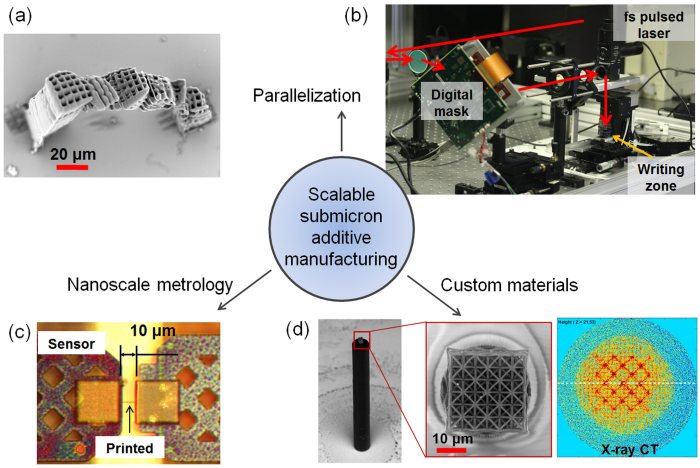Sourabh Saha (16-ERD-047)
Executive Summary
We are designing and developing the materials and equipment necessary to implement a system to produce novel polymer material needed to form patterns used in additive manufacturing and photolithography. This research has the potential to improve the rate, resolution, and scalability of additive manufacturing, with applications in high-energy-density science and stockpile-stewardship science.
Project Description
We are designing and developing the materials and equipment necessary to implement a sub-micrometer-scale projection-stereolithography additive-manufacturing system based on parallel two-photon polymerization with ultrashort laser pulses. A projection-stereolithography system adapts three-dimensional printing for materials fabrication. Additive manufacturing generates complex three-dimensional structures by controlling the geometry and material properties of individual building blocks; the two-photon polymerization technique enables this level of control over sub-micrometer building blocks. The technique uses a nonlinear photo-absorption process to polymerize sub-micrometer features within the interior of the resists, the light-sensitive material used to form a pattern in additive manufacturing and photolithography. After illumination of the desired structures inside the photo-resist volume and subsequent development (washing out the non-illuminated regions), the polymerized material remains in the prescribed three-dimensional form. Although two-photon polymerization enables fabricating features on a length scale that is not possible by other additive-manufacturing techniques, it is currently limited to a low processing rate and a small set of materials. This limits our ability to take full advantage of its sub-micrometer geometric control to fabricate parts. Thus, there is a compelling need to increase the material-processing rate and to develop custom two-photon polymerization resists. Technological and scientific challenges in solving these rate and material limitations arise because of the slow point-by-point serial-illumination technique of the existing systems and the inability to measure and characterize the mechanical properties of additively manufactured parts fabricated with novel resists. In this research project, we will address these challenges by creating a parallel process via a temporal focusing technique to perform plane-by-plane simultaneous illumination and by re-purposing micro-electromechanical system sensors to measure the mechanical properties of novel two-photon polymerization resists via direct nanometer-scale metrology of the individual building blocks.
We expect to generate the scientific knowledge, hardware, and materials to (1) fabricate millimeter-scale parts with sub-micrometer building blocks, (2) increase the rate of existing sub-micrometer additive manufacturing by at least 10 times and potentially up to 1,000 times, and (3) perform metrology-driven design of custom resists that have desirable mechanical properties. Although the underlying technologies for each of these exists separately, they have never been integrated together in the form of a functional sub-micrometer additive-manufacturing system. Thus, results of this project will fundamentally advance the state of the art in rate, resolution, and scalability of additive manufacturing. Additionally, the hardware and knowledge generated will substantially expand Lawrence Livermore National Laboratory's existing sub-micrometer additive-manufacturing capabilities for applications such as target fabrication for the Laboratory's National Ignition Facility and the Laboratory for Laser Energetics' OMEGA Laser in Rochester, New York. There is an immediate need for a faster process and custom two-photon resists to support these applications. In addition, this project will significantly expand the range and capabilities of hardware and resists available to the Laboratory and other users in the future. Finally, it will ensure Livermore's continued scientific and technical leadership in the area of sub-micrometer additive manufacturing and establish collaborations with the Chinese University of Hong Kong and the University of Texas at Austin.
Mission Relevance
This project will strengthen Livermore's advanced materials and manufacturing capabilities by generating the underlying science and technology of sub-micrometer additive manufacturing. In addition, by generating the knowledge and hardware for parallel two-photon polymerization, this work will directly support laser target fabrication efforts at the laboratory relevant to current and future mission challenges in high-energy-density science and stockpile stewardship science, in support of the DOE goal of nuclear security to strengthen key science, technology, and engineering capabilities and modernize the national security infrastructure.
FY17 Accomplishments and Results
In FY17 we (1) designed and fabricated the first version of our onsite additive-manufacturing system; (2) integrated a high-power laser into the system; (3) developed and extensively tested custom iodized two-photon resists to ensure that performance meets or exceeds those of commercial resists (a patent application has been filed for this resist formulation); (4) designed and fabricated hardware to support the design of stretchable resists, which will enable an alternate writing technique that overcomes the optics-based challenges of printing tall millimeter-scale structures with an index-mismatched resist; (5) tested this hardware to print with elastomeric resist materials; (6) designed and fabricated custom micro-electromechanical sensors with the desired range and resolution, in collaboration with University of Texas at Austin; and (7) developed and experimentally verified a new parallel-writing technique (grey-scale printing) to optimize additive-manufacturing performance, in collaboration with the Chinese University of Hong Kong.
Publications and Presentations
Ladner, I., et al. 2017. "Design of High Resolution and High Force MEMS Tensile Testers for Direct Metrology of Additively Manufactured Submicron Features." American Society for Precision Engineering 32nd Annual Meeting. LLNL-ABS-728286.
Nguyen, V., et al. 2017. "Loss of Dimensional Accuracy Due To Non-Uniform Shrinkage in Additively Manufactured Polymer Parts Fabricated by Two-Photon Lithography." EUSPEN Special Interest Group Meeting: Additive Manufacturing. LLNL-ABS-730141.






